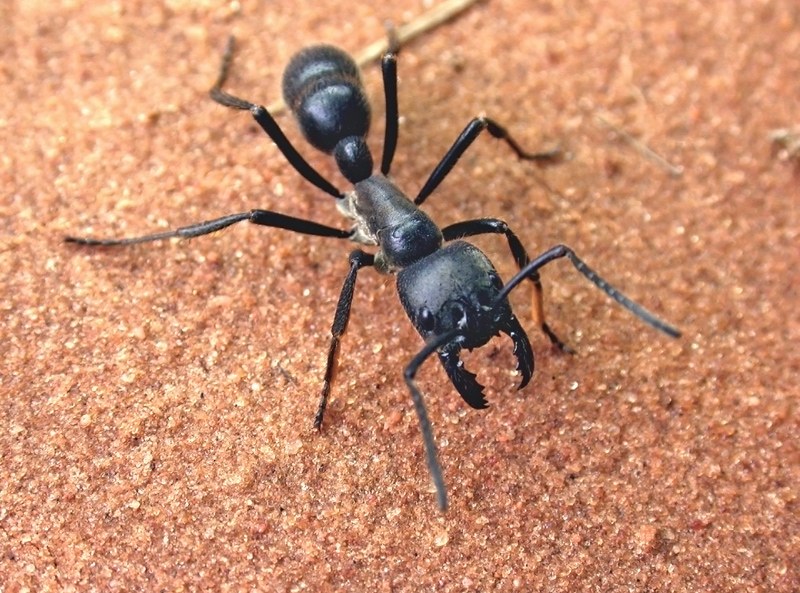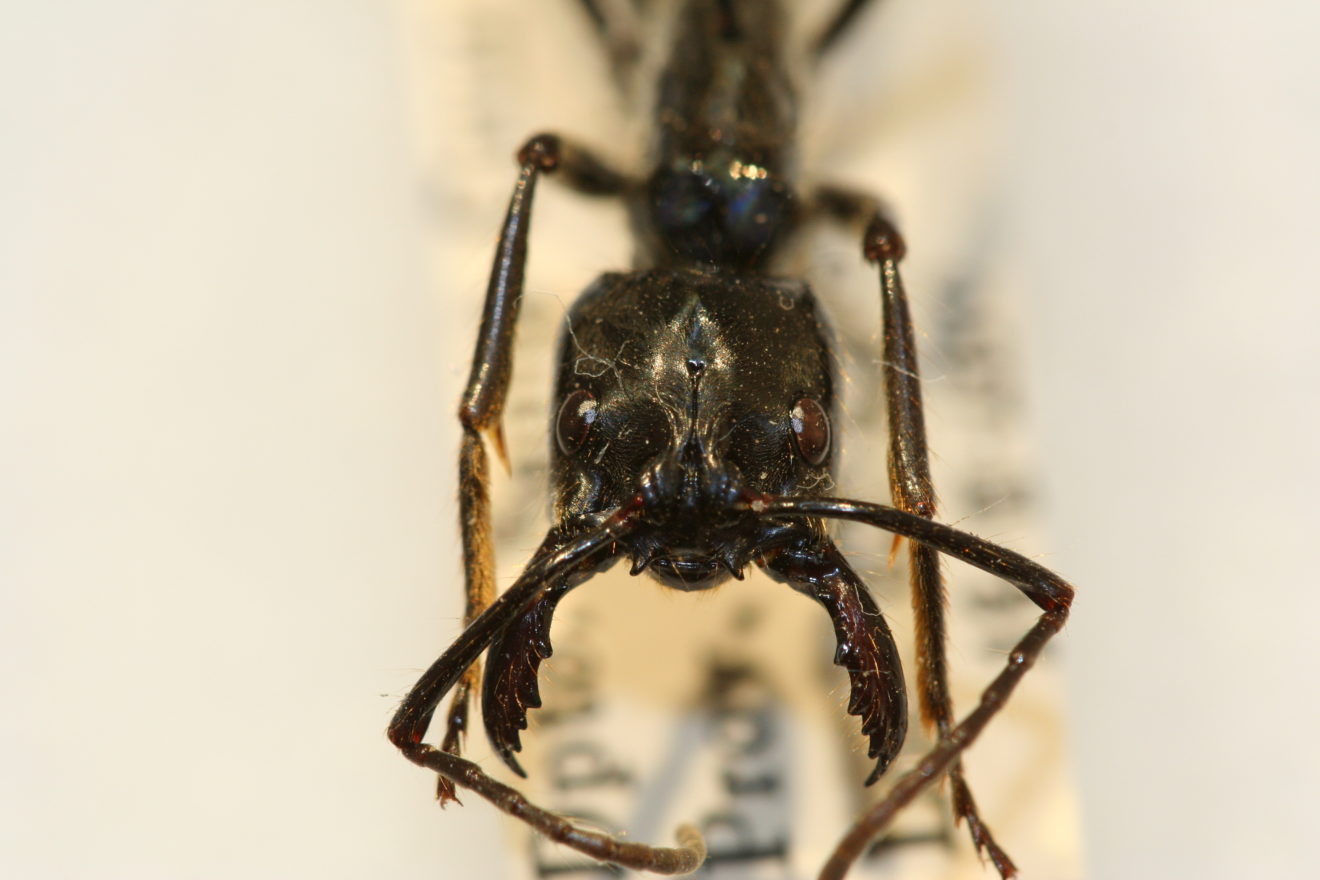Ants are eusocial insects of the family Formicidae and, along with the related wasps and bees, belong to the order Hymenoptera. There are 341 valid species and subspecies of ants in Guyana. The giant Amazonian ant also called tocandiras, is among these many species.
This Amazonian ant is a strictly South American genus of ant in the subfamily Ponerinae. They are generally less well known than Paraponera clavata, the bullet ant, yet the Amazonian ant females may surpass 3 to 4 centimetres (1.2–1.6 in) in total body length, making them among the largest ants in the world.

Dinoponera australis | https://www.wired.com/2014/04/top-predator-giant-ant/
Species Of The Giant Amazonian Ants
- Dinoponera australis
- Dinoponera hispida
- Dinoponera gigantea
- Dinoponera longipes
- Dinoponera lucida
- Dinoponera mutica
- Dinoponera quadriceps
- Dinoponera snellingi Lenhart
The species found in Guyana is called the Dinoponera gigantean, which is a species of ants belonging to the family Formicidae. Dinoponera gigantea is one of the world’s largest species of ant. The females of the species are larger than males and are coal-black in color, while the much smaller males are dark red.
Scientific Classification Of The Giant Amazonian Ants
Giant Amazonian Ants – Dinoponera gigantean [Scientific name]
- Kingdom: Animalia
- Phylum: Arthropoda
- Class: Insecta
- Order: Hymenoptera
- Family: Formicidae
- Subfamily: Ponerinae
- Tribe: Ponerini
- Genus: Dinoponera
- Species: D. gigantean
The Amazonian Ant’s Lifestyle
Their colonies have as many as eight entrances to their underground chambers, each being 3 to 8 centimetres in diameter. The entrances are, as is typical for ants, surrounded by the soil removed to make the nest, but, in contrast with other species, no mound is formed. Nests have been found to be about 40 centimetres deep, with chambers approximately 3 centimetres in height and 20 centimetres in width.
At least in some instances, the species is polydomous, with a single colony occupying and maintaining more than one nest at a time. Some instances of this were recorded in Fourcassie and Oliveira’s 2002 study, which found colonies using multiple nests, the entrances of which were 40 to 250 centimetres apart.
The Amazonian Ant’s Food Hunt
Activity outside the nest is highest at sunrise and sunset, though it is likely that some activity occurs at night. Individuals search for food alone, generally within about 10 metres of the nest. Items brought back range from 10 to 400 milligrams, and are of wide variety, including both plant and animal matter. Food items include fruits of vismia plants, inga seeds, and various small animals such as spiders, crickets, and snails. A relatively small number, around 10%, of foraging trips turn out to be successful. Successful foraging trips are typically thirty to sixty minutes in duration, but may run as long as three hours.
The Amazonian Ant’s Territorial Defense
Neighboring colonies of the Amazonian ants have distinct foraging areas. On the occasion that ants from different colonies meet on the border of these areas, the individuals face each other, locking their mandibles. The two then repeatedly poke each other’s head with their antennae while kicking with the forelegs. At some point, one of the ants gains a dominant position, eventually biting the other on the top of the head and pressing the gaster against the loser’s body. The entire encounter can last up to half an hour. In Fourcassie and Oliveira’s study, both ants were invariably found to be uninjured.
The Amazonian Ant’s Reproduction
The alpha female mates with non-nestmate males at night at the entrance of the nest. After copulation the female bites through the male’s gaster to release herself and pulls out the genital capsule which acts as a temporary sperm plug. After mating the female is unreceptive to other males and remains monandrous. The gamergate (a mated worker ant that is able to reproduce sexually) maintains dominance with ritualized behaviors such as antennal boxing and biting, “blocking”, as well as gaster rubbing and curling.
The Amazonian Ant’s Habitat
They are present only in South America. It has been found on the coast of Guyana, in the Brazilian states of Amazonas, Pará including Marajo Island, Mato Grosso, Mato Grosso do Sul and Maranhão as well as the Loreto Province in Peru. The Amazonian ant is reported to be common in un-flooded forests in the vicinity of Belém, Pará. It is probable that they are also found in French Guiana, Suriname, Venezuela and southeastern Colombia because these regions are adjacent to known Amazonian ant localities and have similar lowland rainforest habitat.
Giant Amazonian Ants In Guyana
In Guyana there are many ants; they are all over – on the kitchen counter, in the dining room, around snacks, outside, in the backyard. They are so tiny, sometimes you don’t even notice them running along. However, among these ants is one of the largest species in the world – the Dinoponera gigantean. They can be found in the rainforest of Guyana; inarguably, their lifestyle, the way they hunt for food, their territorial defense and even their reproduction are all interesting facts for this one of a kind species of ant that is among the largest in the world.
Article References:
- https://en.wikipedia.org/wiki/Ant
- https://en.wikipedia.org/wiki/Dinoponera
- https://en.wikipedia.org/wiki/Dinoponera_gigantea







